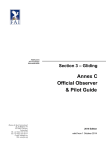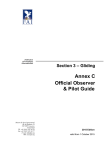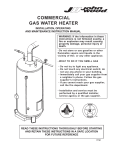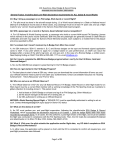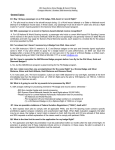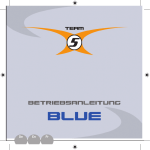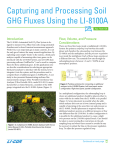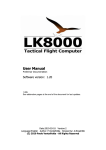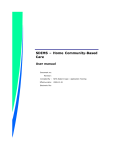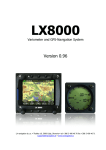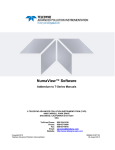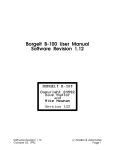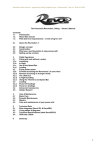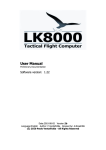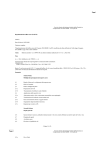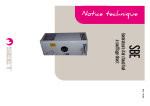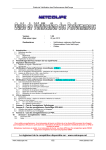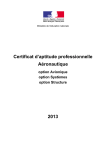Download FAI badge
Transcript
FAI Sporting Code Section 3 – Gliding CLASS D (gliders) Including Class DM (motorgliders) 2009 Edition – AL0 This amendment is valid from 1 October 2009 FÉDÉRATION AÉRONAUTIQUE INTERNATIONALE Avenue Mon Repos 2, CH 1005 – Lausanne, Switzerland http://www.fai.org e-mail: [email protected] Copyright 2009 All rights reserved. Copyright to this document is owned by the Fédération Aéronautique Internationale (FAI). Any person acting on behalf of the FAI or one of its members is hereby authorised to copy, print, and distribute this document, subject to the following conditions: 1. The document may be used for information only and may not be exploited for commercial purposes. 2. Any copy of this document or portion thereof must include this copyright notice. Note that any product, process or technology described in the document may be the subject of other intellectual property rights reserved by the Fédération Aéronautique Internationale or other entities and is not licensed hereunder. ii SC3-2009-AL0 Fédération Aéronautique Internationale Sporting Code Section 3 – Gliders The FAI Sporting Code for gliders (the “Code”) sets out the rules and procedures to be used to verify soaring performances. The essence of these rules is to ensure that a soaring performance is achieved to a level of proof that is consistent for all flights. When processing the evidence supplied, Official Observers (OO) and the National Airsport Control (NAC) should ensure that these rules are applied in the spirit of fair play and competition. In Chapter 1 of the Code, a word or phrase appearing in small capital letters indicates that it has a distinct definition as it applies to the Code. References outside a chapter are by paragraph number. Text in italic is informational in nature and not part of the rules and regulations of the Code. iii SC3-2009-AL0 Rights to FAI international sporting events All international sporting events organised wholly or partly under the rules of the 1 Fédération Aéronautique Internationale (FAI) Sporting Code are termed FAI Inter2 3 national Sporting Events . Under the FAI Statutes , FAI owns and controls all rights 4 relating to FAI International Sporting Events. FAI Members shall, within their national 5 territories , enforce FAI ownership of FAI International Sporting Events and require 6 them to be registered in the FAI Sporting Calendar . Permission and authority to exploit any rights to any commercial activity at such events, including but not limited to advertising at or for such events, use of the event name or logo for merchandising purposes and use of any sound and/or image, whether recorded electronically or otherwise or transmitted in real time, must be sought by way of prior agreement with FAI. This includes specifically all rights to the use of any material, electronic or other, that form part of any method or system for judging, scoring, performance evaluation 7 or information utilised in any FAI International Sporting Event . 8 Each FAI Air Sport Commission is authorised to negotiate prior agreements on behalf of FAI with FAI Members or other entities as appropriate, of the transfer of all or parts of the rights to any FAI International Sporting Event (except World Air Games 9 10 events ) which is organised wholly or partly under the Sporting Code section for 11 which that Commission is responsible . Any such transfer of rights shall be by 12 “Organiser Agreement” as specified in the current FAI Bylaws Chapter 1, paragraph 1.2, Rules for Transfer of Rights to FAI International Sporting Events. Any person or legal entity accepting the responsibility for organising an FAI Sporting Event, whether or not by written agreement, in doing so also accepts the proprietary rights of FAI as stated above. Where no formal transfer of rights has been established, FAI retains all rights to the event. Regardless of any agreement or transfer of rights, FAI shall have, free of charge for its own archival and/or promotional use, full access to any sound and/or visual images of any FAI Sporting Event, and always reserves itself the right to have any and all parts of any event recorded, filmed and/or photographed for such use, without charge. 1 2 3 4 5 6 7 8 9 10 11 12 FAI Statutes, Chapter 1, para 1.6 FAI Sporting Code, General Section, Chapter 3, para 3.1.3 FAI Statutes, Chapter 1, para 1.8.1 FAI Statutes, Chapter 5, paras 5.1.1.2, 5.5, 5.6, and 5.6.1.6 FAI Bylaws, Chapter 1, para 1.2.1 FAI Statutes, Chapter 2, para 2.3.2.2.5 FAI Bylaws, Chapter 1, para 1.2.3 FAI Statutes, Chapter 5, paras 5.1.1.2, 5.5, 5.6, and 5.6.1.6 FAI Sporting Code, General Section, Chapter 3, para 3.1.7 FAI Sporting Code, General Section, Chapter 1, paras 1.2 and 1.4 FAI Statutes, Chapter 5, para 5.6.3 FAI Bylaws, Chapter 1, para 1.2.2 iv SC3-2009-AL0 Amendment list (AL) record Formal amendments are published by the FAI Secretariat, acting for the International Gliding Commission (IGC). Within nations, the organisation responsible for National Airsport Control (NAC) for gliding is then responsible for distributing amendments to all holders of Section 3 of the Sporting Code (SC3). This amendment list is for SC3 only – separate lists exist for the annexes to SC3. A proposal for an amendment to the Sporting Code or its annexes must be submitted to the IGC Bureau at least six months prior to the next IGC Plenary meeting. A proposal must refer to the paragraphs affected and give reasons for the amendment. It is preferable for the proposed change to be in the format of the Code. The Bureau will review the proposal and determine if it is “substantial” or otherwise, following input from the specialist subcommittee. The Bureau will instruct the specialist subcommittee to process items that are clarifications of existing rules, or prepare discussion papers on substantial proposals for consideration at the next Plenary meeting. At the Plenary meeting, the philosophy behind a substantial amendment will be considered and set. The specialist subcommittee will then draft the Code amendment with Bureau feedback, and have it tested as required. The proposed amendment will then be put on the IGC web site prior to the following Plenary meeting, at which time it will be submitted for approval or rejection. See the action flowchart opposite for details. A Code clarification becomes effective on 1 October following approval by the Bureau. A substantial change become effective on 1 October following the IGC meeting at which it is approved, except that if it has flight safety implications it may be approved by the Bureau prior to the IGC meeting. AL # Action date of AL Amended by (signature) 0 1 Oct 2009 AL0 are original pages Name Date amended Fédération Aéronautique Internationale Avenue Mon Repos 24 CH 1005 – Lausanne Switzerland Tel: +41 21 345 1070 Fax: +41 21 345 1077 http://www.fai.org/gliding/ e-mail: [email protected] v SC3-2009-AL0 Sporting Code review and change process Code change proposal sent to IGC Bureau Sub-committee reviews change proposal and drafts amendment No IGC Bureau determines the change is substantial Yes Bureau proposes rule philosophy IG Plenary sets philosophy No IGC Bureau accepts amendment Subcommittee drafts amendment Yes Arrange trials of amendment as necessary Sporting Code updated as of 1 Oct Year One Year Two IGC Bureau accepts amendment No Yes Publish proposed amendments on IGC web site Sporting Code updated as of 1 Oct Yes IGC Plenary approves amendment No When amendments have been made to the Code, a copy of the amendment list instructions should be inserted after this page so that, later, the subjects of the amendment may be easily identified. Alternatively, users may download the amended Code from the document page of the FAI web site. The latest amendments are indicated by a vertical line to the right of any paragraph that has been changed, as shown here. vi SC3-2009-AL0 TABLE OF CONTENTS paragraph Chapter 1 1.0 1.1 1.2 1.3 1.4 3.2 3.3 Verification requirements and methods Official Observers and certification Official Observer authority ...................................................................................... Flight certification .................................................................................................... Certificates .............................................................................................................. FAI record claim forms .......................................................................................... Submission of claims ............................................................................................. Chapter 6 6.0 6.1 6.2 6.3 6.4 6.5 6.6 World gliding records Flight data requirements .......................................................................................... 11 Declaration requirements ........................................................................................ 11 Flight data verification ............................................................................................ 12 Calculations and calibrations ................................................................................ 12 Flight evidence requirements .................................................................................. 13 Appendix – Use of GPS position recorders for Silver & Gold badge flights.......... 15 Chapter 5 5.1 5.2 5.3 5.4 5.5 7 7 8 General..................................................................................................................... 9 Record categories, classes, and types ................................................................. 9 Table 2 – Types of record flights ......................................................................... 10 Falsification of evidence ........................................................................................ 10 Time limits on record claims ................................................................................ 10 Chapter 4 4.1 4.2 4.3 4.4 4.5 1 1 2 2 3 6 FAI badges General ................................................................................................................... Badge requirements .............................................................................................. Badge design ......................................................................................................... Chapter 3 3.0 3.1 General rules and definitions Introduction ............................................................................................................ General definitions .................................................................................................. Definitions of flight terms ........................................................................................ Definitions of soaring measurement terms ............................................................ Soaring performance types and requirements ...................................................... Table 1 – Table of tasks & requirements ............................................................... Chapter 2 2.0 2.1 2.2 page 16 17 17 18 18 Glider classes and international competitions General ................................................................................................................... Class conformity ...................................................................................................... Handicapping ......................................................................................................... Time period for class changes .............................................................................. World championships ............................................................................................ Competition classes ............................................................................................... International competitions ..................................................................................... 19 19 19 20 20 20 21 Index .................................................................................................................... 22 vii SC3-2009-AL0 this page blank viii SC3-2009-AL0 Chapter 1 GENERAL DEFINITIONS and RULES 1.0 INTRODUCTION 1.0.1 The General Section of the Sporting Code (GS) contains general definitions and rules that apply to all air sports. This Section (SC3) gives specific rules that apply to FAI badge and record flights in gliders and motor gliders defined in GS 2.2.14 as “Class D” aircraft. A GLIDER is a fixed wing aerodyne capable of sustained soaring flight and having no Means of Propulsion (MoP). A MOTOR GLIDER is a fixed wing aerodyne equipped with a MoP, capable of sustained soaring flight without thrust from the MoP. 1.0.2 Terms, rules, and requirements in SC3 are defined first in their most general sense. Where an exception to a general rule exists, it will be described in the text of the Code where the exception occurs. For example, the term “glider” includes “motor glider” unless the difference is relevant in the given text. Reference to a flight recorder or GPS position recorder implies all recorders if more than one is carried on a flight. 1.0.3 SC3 includes the following annexes: a. Annex A Contains rules for world and other FAI-sanctioned gliding competitions. b. Annex B Covers requirements for equipment used for flight validation. c. Annex C Gives non-regulatory guidance, methods and sample calculations to assist Official Observers and pilots in complying with SC3. d. Annex D Contains the rules for the IGC Ranking list that gives the current World ranking position of pilots who have entered IGC competitions. 1.0.4 Records available within FAI Class D are defined by SC3 in the following sub-classes: a. OPEN any FAI Class D aircraft. b. 15 METRE any FAI Class D aircraft with a wingspan not exceeding 15,000 mm. c. WORLD a PW-5 glider as defined in Chapter 6.5.5. d. ULTRALIGHT an FAI Class D aircraft with a takeoff mass not exceeding 220 kg. (A MICROLIFT glider is an ULTRALIGHT with a wing loading not exceeding 18 kg/m2 . It does not have separate records). 1.0.5 Within SC3, “record” applies to world records, “badge” applies to flights at FAI Silver, Gold, Diamond or Diploma achievement levels and “NAC” refers to each National Airsport Control organization having administrative responsibility for these gliding activities. 1.0.6 Related documents The FAI document, “Technical Specifications for IGC-Approved GNSS Flight Recorders” gives information for FR manufacturers. Section 6 covers gliding aerobatic competition, Section 7, hang gliders and paragliders (GS 2.2.1.13, class O), and Section 10, microlights (GS 2.2.1.15, class R). Gliding championship classes are defined in SC3, paragraph 6.5. 1.1 GENERAL DEFINITIONS OFFICIAL OBSERVER 1.1.1 The person having control of a flight undertaken for an FAI badge or record attempt and of the data gathered to prove the SOARING PERFORMANCE (Chapter 5 refers). DECLARATION 1.1.2 The official pre-flight data and description of a SOARING PERFORMANCE (details in 4.2). GNSS / GPS 1.1.3 A Global Navigation Satellite System such as the Global Positioning System (GPS) using multiple satellites operating with receivers to create position data. FLIGHT RECORDER 1.1.4 An electronic device that has been approved by the IGC to record GPS flight data. page 1 SC3-2009-AL0 GPS POSITION RECORDER 1.1.5 A GPS device that can record time and horizontal position. The Appendix to Chapter 4 defines their approval and use. BAROGRAPH 1.1.6 An electronic recording barometer incorporated into a FLIGHT RECORDER or a stand-alone mechanical or electronic device. BAROGRAM 1.1.7 The altitude data output of a FLIGHT RECORDER or electronic BAROGRAPH or the “trace” recorded by a mechanical BAROGRAPH. MEANS of PROPULSION 1.1.8 (MoP) RECORDER A device that records noise level or other data indicating MoP use. A device failure must either register as MoP use, or as MoP data with a numeric value of “000” in the .igc file. 1.2 DEFINITIONS of FLIGHT TERMS SOARING PERFORMANCE 1.2.1 The portion of a glider flight from the START POINT to the FINISH POINT. WAY POINT 1.2.2 A point on the surface of the earth precisely specified by a set of coordinates or by a word description. A WAY POINT may be a START POINT, TURN POINT, or FINISH POINT. LEG 1.2.3 The straight line between two successive WAY POINTS. The claimed length of a LEG may be reduced as given in 1.3.9. COURSE 1.2.4 All the LEGS of a SOARING PERFORMANCE. A CLOSED COURSE has the START and FINISH at the same WAY POINT. OBSERVATION ZONE 1.2.5 The airspace a glider must enter to attain a WAY POINT. An OBSERVATION ZONE (OZ) may be either a CYLINDER (1.3.6) that is usable for TURN POINTS only, or a SECTOR (1.3.8) that is useable for all WAY POINTS. A START LINE or FINISH LINE has no OZ. RELEASE POINT 1.2.6 The point on the ground vertically below where the glider releases or ceases using a MoP. FIX 1.2.7 A single data point selected from recorded flight data giving latitude, longitude, time, and from a FLIGHT RECORDER, pressure altitude. START POINT 1.2.8 The WAY POINT that marks the beginning of a SOARING PERFORMANCE at either: a. the RELEASE POINT, b. a declared START POINT, c. the midpoint of a START line, or d. on a free record flight, a FIX selected post-flight as a START POINT. START LINE 1.2.9 A horizontal line, 1 km in length, oriented approximately perpendicular to the first LEG. The midpoint of the line (the START POINT) is at ground level. TURN POINT 1.2.10 A WAY POINT between two LEGS of a flight. FINISH POINT 1.2.11 The WAY POINT that marks the end of a SOARING PERFORMANCE at either: a. the landing, where the nose of the glider comes to rest without external assistance, b. a declared FINISH POINT, or c. the midpoint of a FINISH line, or d. a FIX selected post-flight as a FINISH POINT, or established by starting a MoP. FINISH LINE 1.2.12 A horizontal line, 1 km in length, oriented approximately perpendicular to the last LEG. The midpoint of the line (the FINISH POINT) is at ground level. GOAL FLIGHT 1.2.13 A SOARING PERFORMANCE that requires a declared START and FINISH POINT. (1.4.4 and 1.4.6 refer.) page 2 SC3-2009-AL0 START TIME and ALTITUDE 1.3 DEFINITIONS of SOARING MEASUREMENT TERMS 1.3.1 The time and altitude (msl) at which the SOARING PERFORMANCE begins, both determined by the type of SOARING PERFORMANCE and the type of START POINT claimed: a. When a declared START POINT is not required for a given performance, START TIME and ALTITUDE may be taken at the RELEASE POINT or, for a free distance performance, at a FIX selected post-flight as the START POINT. b. When a declared START POINT is claimed for a distance performance, START TIME and ALTITUDE may be taken at: (i) the exit from the START OZ SECTOR, (ii) the crossing of a START LINE, or (iii) the most favourable FIX recorded within the START OZ SECTOR. The SECTOR OZ radius for GOAL or CLOSED COURSE distance performances is 1000m. FINISH TIME and ALTITUDE c. For speed performances, a declared START / FINISH POINT is required; START TIME and ALTITUDE must be taken at an exit from the START OZ SECTOR with a 1000 metre radius or on crossing a START LINE. 1.3.2 The time and altitude (msl) at which a SOARING PERFORMANCE ends, both determined by the type of SOARING PERFORMANCE and the type of FINISH POINT claimed: a. For a finish at landing (1.2.11a), FINISH TIME is the time of landing and FINISH ALTITUDE is the landing site msl elevation. b. For an airborne finish at a declared FINISH POINT, FINISH TIME and ALTITUDE may be taken at: (i) the glider’s entry into the FINISH OZ SECTOR, (ii) the crossing of a FINISH LINE, or (iii) a FIX within the FINISH OZ SECTOR. The SECTOR OZ radius for a GOAL or CLOSED COURSE flight is 1000m. c When a declared FINISH POINT is not claimed, FINISH TIME and ALTITUDE may be taken at landing, starting of the MoP, or any FIX selected as the FINISH POINT. Paragraph A.7 to the Chapter 4 Appendix gives provisions for start and finish altitudes and times when a GPS position recorder is used. DURATION 1.3.3 The elapsed time between the START TIME and the FINISH TIME. LOSS OF HEIGHT 1.3.4 The START ALTITUDE minus the FINISH ALTITUDE (4.4.3 refers). GAIN OF HEIGHT 1.3.5 The greatest altitude difference between a recorded high point and a previous low point during a SOARING PERFORMANCE. CYLINDER OZ 1.3.6 The airspace within a vertical cylinder of 500 metres radius centred on a TURN POINT. OZ CORRECTION 1.3.7 Each time a LEG crosses a CYLINDER OZ boundary, 500 metres shall be subtracted from the length of that LEG. This correction does not apply where a FIX is used as a WAY POINT in free record performances. SECTOR OZ 1.3.8 The airspace above a quadrant having its apex at the WAY POINT. Except as limited by 1.3.1 and 1.3.2 for CLOSED COURSE and GOAL flights, the radius of the OZ is unlimited and its orientation is: OFFICIAL DISTANCE a. For a TURN POINT, symmetrical to and remote from the bisector of the inbound and outbound LEGS at the TURN POINT, b. For a START POINT, symmetrical to and remote from the outbound LEG, c. For a FINISH POINT, symmetrical to and remote from the inbound LEG. 1.3.9 The sum of the LEGS, with OZ CORRECTION deducted where applicable, less any LOSS OF HEIGHT penalty. This distance is to be used in any calculation of COURSE speed. page 3 SC3-2009-AL0 1.4 SOARING PERFORMANCE TYPES and REQUIREMENTS The following paragraphs define all the SOARING PERFORMANCES that may be flown for records or badges. Table 1 at the end of this chapter presents the information in spreadsheet form. 1.4.1 a. General A SOARING PERFORMANCE may be claimed from any flight that meets the requirements of proof for that performance. b. A DECLARATION and electronic flight data are required except where specifically exempt (4.2 refers). c. WAY POINTS must be declared and used in the sequence declared, except where specific- ally not required in these rules. d. No more than three TURN POINTS may be declared and no more than four LEGS may be claimed for a SOARING PERFORMANCE. 1.4.2 Duration, gain of height and absolute altitude performances A DECLARATION is not required for duration and gain of height badge flights that use only a barograph for evidence. The SOARING PERFORMANCE for an absolute altitude record must be preceded by a gain of height of at least 5000 metres. 1.4.3 Distance performance for badges only A COURSE having one LEG, with distance measured from the STRAIGHT DISTANCE RELEASE POINT or a declared START POINT to any type of FINISH POINT. If no WAY POINTS are declared, data recording by a stand-alone barograph is sufficient. 1.4.4 Distance performance for records only A COURSE having one LEG, with OFFICIAL DISTANCE measured from a declared START POINT to a declared FINISH POINT. The OZ radius at each of these WAY POINTS is 1000 metres. DISTANCE TO A GOAL 1.4.5 Distance performance for badges and records A COURSE with distance measured from the RELEASE POINT or a declared START POINT to any type of FINISH POINT, via at least one and not more than three declared TURN POINTS. TURN POINTS may include the START POINT and/or FINISH POINT if desired. The TURN POINTS must be at least 10 kilometres apart, and each may be claimed only once in the sequence attained. DISTANCE USING UP TO THREE TURN POINTS 1.4.6 Distance and speed performances for badges and records The following CLOSED COURSES may be used for badge distance and must be used for speed records and Diamond Goal flights. All WAY POINTS must be declared, and the OZ SECTOR radius at the START and FINISH is 1000 metres. a. OUT AND RETURN FLIGHT b. TRIANGLE FLIGHT (i) A CLOSED COURSE having two LEGS. A CLOSED COURSE having three LEGS. The geometry may be either: A triangle having two TURN POINTS, or (ii) A triangle having three TURN POINTS independent of the position of the START/FINISH POINT. The distance is given by the sum of the LEGS of the triangle formed by the TURN POINTS. The minimum OFFICIAL DISTANCE (1.3.9) is 300 kilometres. For triangle record COURSES of 750 km or more, the length of each LEG shall be 25% to 45% of the OFFICIAL DISTANCE. For record COURSES shorter than 750 km, no LEG may have a length of less than 28% of the OFFICIAL DISTANCE. 1.4.7 Free distance performances for records only Free distance WAY POINTS may be selected from FIXES claimed post-flight. The free distance record types are: page 4 SC3-2009-AL0 a. FREE STRAIGHT DISTANCE b. FREE DISTANCE USING UP TO THREE TURN POINTS 1.4.8 A COURSE having one LEG. A COURSE via at least one, and not more than three TURN POINTS. TURN POINTS may include the START POINT and/or FINISH POINT if desired. TURN POINTS must be at least 10 km apart and each may be claimed only once. Free distance closed course records The START POINT is a FIX chosen by the pilot to suit the record being claimed. This location also marks the apex of a 1000 metre radius FINISH OZ SECTOR that the pilot must enter to complete the course. The free distance closed course record types are: a. FREE OUT AND RETURN DISTANCE A CLOSED COURSE having two LEGS. b. FREE DISTANCE AROUND A TRIANGLE A CLOSED COURSE having three LEGS. The restrictions on triangle geometry given in 1.4.6b apply. The pilot may fly either: (i) A triangle using two TURN POINTS, or (ii) A triangle using three TURN POINTS independent of the position of the START/FINISH POINT. In this case, the triangle distance is given by the sum of the LEGS of the triangle formed by the TURN POINTS. page 5 SC3-2009-AL0 SOARING PERFORMANCE SC3 Citation Task Choices Maximum Items required # of TPs in declaration declared / claimed Distance to a Goal 1.4.4 Record Out & Return flight 1.4.6a 2.1.3b Triangle flight (2 Turn Points) 1.4.6b(i) 2.1.3b Triangle flight (3 Turn Points)) 1.4.6b(ii) 2.1.3b Free Straight Distance or claimed Fix MoP stop 1 OK 4.2.1 a to g 3/3 2 to 4 3/0 1 1/1 2 as No appropriate 2/2 & Distance or OK (unlimited) anywhere (unlimited) anywhere Only in FINISH OZ Sector Required (1000 m) Only in FINISH OZ Sector Required (1000 m) 1.4.7a 3/0 1 Free Distance using up to 3 Turn Points 1.4.7b 3/3 2 to 4 Free Out & Return Distance 1.4.8a 3/1 2 Distance Record 4.2.1 a to d OK 3/2 1.4.8b(ii) Absolute Altitude 1.4.2 3.1.2b Record Gain of Height 1.3.5 1.4.2 Badge or Record Duration 1.3.3 1.4.2 Badge 3/3 4.2.1 a to d as appropriate page 8 START POINT (1000 m) Only in FINISH OZ Sector at declared START POINT OK OK OK (unlimited) anywhere (unlimited) anywhere OK 3 (1000 m) Free Triangle Distance (3 Turn Points) OK OK OK 1.4.8b(i) declared OZ Sector at declared POINT Same as Only in FINISH START POINT 3 (1.2.11d) (OZ radius) OK Speed Record 3/3 Free Triangle Distance (2 Turn Points) START 3 Finish Point OK as the Diamond Goal (1.2.11a) Using a Finish Fix Only if declared Badge Distance, Start Point (OZ radius) Landing Finish Line or declared OK in FINISH OZ Sector at claimed START POINT 3 OK at declared START POINT (1000 m) OK in FINISH OZ Sector at claimed START POINT N • When a start or finish line is used there is no OZ in effect. O • GPS position recorders are permitted as provided for in the Appendix to Chapter 4. T • 3-TP triangle distance for badges and records is measured: TP1 – TP2 – TP3 – TP1. E • For records, the minimum leg length for distance or speed triangles of less than 750 km is 28% of the official S T Badge or Record START By A 1.4.5 Legs Start Line or declared B Distance using up to 3 Turn Points 3/0 Release L Badge FR E 1.4.3 Course FINISH ALTERNATIVES 1 Straight Distance START ALTERNATIVES TABLE 1 GENERAL REQUIREMENTS distance. For courses 750 km or longer, no leg may be less than 25% or more than 45% of the official distance. SC3-2009-AL0 Chapter 2 FAI BADGES This chapter defines and gives the requirements to meet the international standard levels of soaring achievement. 2.0 GENERAL The FAI badges are international standards of achievement that are not required to be renewed. Flights qualifying for badges shall be controlled in accordance with the requirements of this Code. The distance requirement for each badge shall be the calculated official distance (1.3.9). 2.0.1 The pilot must be alone in the glider, and the OO must certify that this was the case. 2.0.2 Each NAC should keep a register of badge flights it has validated. 2.0.3 In addition to the use of IGC-approved FRs, position for the Silver and Gold badges may be verified with NAC-approved GPS position recorders for flights made within that NAC’s area of authority. See Appendix, Chapter 4. 2.1 BADGE REQUIREMENTS The soaring performances required to qualify for the FAI badge standards of achievement are: 2.1.1 a. Silver Badge The Silver badge is achieved on completing the following three soaring performances: a flight on a straight course of at least 50 km. Any leg of 50 kilometres or more of a longer pre-declared course may qualify, subject to the requirements of 4.4.3 on altitude difference applied to the whole course flown. SILVER DISTANCE The Silver distance flight should be flown without navigational or other assistance given over the radio (other than permission to land on an airfield) or help or guidance from another aircraft. b. SILVER DURATION a duration flight of at least 5 hours. c. SILVER HEIGHT a gain of height of at least 1000 metres. 2.1.2 Gold Badge The Gold badge is achieved on completing the following three soaring performances: a. GOLD DISTANCE a distance flight of at least 300 kilometres, b. GOLD DURATION a duration flight of at least 5 hours, c. GOLD HEIGHT a gain of height of at least 3000 metres. 2.1.3 Diamonds There are three Diamonds, each of which may be worn on the Silver or Gold badge, and the badges for flights of 750 kilometres or more. NACs should maintain a register of these badges and, on notification by a NAC, the FAI will enter the names of pilots attaining the three Diamond award in an international register. a. DIAMOND DISTANCE a distance flight of at least 500 kilometres. b. DIAMOND GOAL a goal flight of at least 300 kilometres over an out-and-return course (1.4.6a) or triangular course (1.4.6b). c. DIAMOND HEIGHT a gain of height of at least 5000 metres. page 7 SC3-2009-AL0 2.1.4 Badges and Diplomas for flights of 750 kilometres and more These are a family of badges that are achieved on completing a distance flight of 750 kilometres or more, in increments of 250 kilometres (ie. 750 km, 1000 km, 1250 km, etc.). One badge is awarded per flight for the incremental distance immediately less than the distance flown. NACs should maintain a register of these badges and on notification by a NAC, FAI will award a special Diploma for flights of 1000 km and more. 2.2 BADGE DESIGN (reproduced approximately twice real size): 2.2.1 Silver and Gold Badge 2.2.2 Three Diamonds Badge (1 & 2 Diamonds similar) 2.2.3 750 Kilometre and more Badges (1000 km illustrated, others and with one and two Diamonds, similar.) page 8 SC3-2009-AL0 Chapter 3 WORLD GLIDING RECORDS This chapter defines and explains the handling of FAI world record claims. General rules relating to records are in the General Section of the Sporting Code. 3.0 GENERAL The following general requirements must be met for a world record: a. No advance notice for an attempt is required provided that arrangements have been made for controlling the flight. b. The pilot must possess a valid FAI Sporting Licence (GS 8.1). c. The flight data must be from a flight recorder approved by the IGC for world records. d. The flight claimed must be first be approved as a national record. 3.1 RECORD CATEGORIES, CLASSES, and TYPES Record categories are concerned with the pilot, record classes with the glider, and record types with the nature of the soaring performance. 3.1.1 Pilot categories The General category includes any pilot; the Feminine category includes only female pilots. 3.1.2 Glider classes World records are recognised in the classes listed in 1.0.4. Multi-place gliders and motor gliders are included in these record classes where applicable. a. MULTI-PLACE GLIDERS b. ALTITUDE RECORDS 3.1.3 All persons on board the glider must be named on the FR declaration and in full on the claim form and be at least 14 years old. Only flight crew members possessing a valid Sporting Licence will be listed by name in the records of the FAI. Absolute altitude and gain of height records are listed in both pilot categories but only in the Open record class ( 3.1.4k and 3.1.4m ). World record achievement margins a. A new record claim must exceed the current value by 1 km for distance, 1 km/h for speed, and 3% for altitude. b. When a new record category, class, or type is created, a minimum level of performance may be set by the IGC that must be exceeded before a world record will be validated. It may be published in this Code, or published separately by the FAI. 3.1.4 Designation of records Glider records are designated by code letters, starting with the FAI code letter for gliders (D), then the glider class concerned, and finally the pilot category (general or feminine): Open Class glider records are designated by adding the letter O. 15m Class glider records are designated by adding the numbers 15. World Class glider records are designated by adding the letter W. Ultralight glider records are designated by adding the letter U. The General pilot category is designated by the letter G. The Feminine pilot category is designated by the letter F. Examples: DWF D15G Gliding, World class, Feminine Gliding, 15 metre class, General page 9 SC3-2009-AL0 TABLE 2 Types of record flights Flight Performance Ref. Remarks (see Chapter 1 for details) Free distance records 3.1.4a Free Straight Distance 3.1.4b Free Distance using up to 3 TPs 3.1.4c Free Out-and-Return Distance 3.1.4d Free Triangle Distance 1.4.7a 1.4.7b 1.4.8a 1.4.8b No turn points 1 to 3 free turn points Closed course with one free turn point Closed course with 2 or 3 free turn points Declared distance records 3.1.4e Distance to a Goal 3.1.4f Distance Using Up to 3 TPs 3.1.4g Out-and-Return Distance 3.1.4h Triangle Distance 1.4.4 1.4.5 1.4.6a 1.4.6b Declared goal with no turn points 1 to 3 declared turn points Closed course with one declared turn point Closed course with 2 or 3 declared turn points Speed records 3.1.4i Speed over an out and return course of 500 km and all multiples of 500 km 1.4.6a 1 declared turn point 3.1.4j 1.4.6b 2 or 3 declared turn points Speed over a triangular course of 100, 300, 500, 750, 1250 km and all multiples of 500 km Altitude records 3.1.4k Absolute altitude 3.1.4m Gain of Height 1.4.2 1.4.2 Open class only, 5000m gain required Open class only 3.2 FALSIFICATION of EVIDENCE Should it be proven that any person involved in a world record claim has altered, concealed, or in any other way misrepresented the evidence with the intent to deceive, the claim shall fail. The FAI will invalidate the Sporting Licences of those guilty of the fraud and may cancel permanently or for a period of time any other award, record, title, etc. it has conferred. The NAC(s) may be asked to cancel the appointment of the OO(s) involved where appropriate (5.1.7 refers). 3.3 TIME LIMITS on RECORD CLAIMS 3.3.1 Claim notice Notice of a claim for a world record must be submitted by the NAC or the OO controlling the attempt, and the FAI must receive the claim within seven days of the flight. In exceptional circumstances, the president of the IGC may grant an extension. Telephone, fax, email, and similar types of notification are acceptable. (GS 6.8.4 refers). 3.3.2 Claim documentation The NAC shall forward claim documentation to reach the FAI within 120 days of the date of the flight unless an extension of time has been authorised by the IGC President (GS 6.8.2 refers), and after it has been approved as a national record. page 10 SC3-2009-AL0 Chapter 4 VERIFICATION REQUIREMENTS and METHODS This chapter defines the evidence, measurements and calculations required to verify soaring performances. Annex C gives examples of ways and means by which this may be done, such as the calculation of distances, and GPS flight recorder data analysis methods. 4.1 FLIGHT DATA REQUIREMENTS A badge or record flight may require evaluation of some or all of the following flight data. Different soaring performances will require subsets of this list: a. b. c. d. e. declaration (1.1.2) start point (1.2.8) start altitude & time (1.3.1) turn point(s) (1.2.9) finish point (1.2.10) f. g. h. i. j. finish altitude & time (1.3.2) absolute altitude (1.4.2) loss of height (1.3.4) gain of height (1.3.5) flight continuity (4.3.2) 4.2 DECLARATION REQUIREMENTS A pre-flight declaration that includes the 4.2.1 items noted below is required for all flights except badge flights that use only a barograph for evidence. The most recent declaration is the valid one. (See Annex C para 6.3 on the format of a flight declaration as it appears in a downloaded .igc file.) a. For record flights, the declaration must be recorded in an .igc file from an FR and must include items 4.2.1a through 1d. Item 4.2.1e is not required for gain of height, absolute altitude, or any free distance record flight. b. For badge flights using evidence from an FR or a GPS position recorder and barograph, the declaration shall be recorded in an .igc file or written on a single sheet of paper. Items 4.2.1a through 1d are required. Item 4.2.1e is not required for straight distance flights claimed from release to the landing or to a finish fix. A written declaration must be signed as in 4.2.1f and 1g, retained by the OO, and submitted with claim materials. c. Where more than one FR is used, they must have identical flight task data input, and if one fails, the other becomes the direct replacement. Consult the FR manufacturer’s user manual to determine which method a FR uses to record declaration date and time. Date and time for a written declaration are as certified by the OO. 4.2.1 Declaration content a. Date of flight. b. Name of the pilot-in-command, and the flight crew if any (see Annex C, para 6.3c). c. Glider type, and its registration or serial number or unique NAC-assigned contest number. d. The make, model and serial number of the FR used (as recorded in the .igc file for the flight). For any barograph or GPS position recorder used, the make, model and serial number as verified by the OO before flight. e. Additional content for distance and speed flights Way points and, for a closed course, the sequence to be flown. f. g. Additional content in written declarations for badge flights Pilot-in-command signature. Official Observer signature, with date and time. 4.2.2 Declaration analysis a. When any way point is declared using a word description, abbreviation or code and coordinates, the coordinates are definitive. When a word description, abbreviation or code alone is used to declare any way point, its coordinates must be taken from a published source designated by the NAC. page 11 SC3-2009-AL0 b. When more than one FR is carried on the flight, data files from each FR must be submitted (paragraph 4.5.6e refers). A difference in the declaration among FRs carried could be grounds for refusal to accept any claim from that flight. 4.3 FLIGHT DATA VERIFICATION 4.3.1 Flight data recording and sampling rate Barograph pressure data must be recorded throughout the flight, with the exceptions allowed in 4.3.2. The flight data must indisputably verify flight continuity and all altitudes critical to the soaring performance. When data is recorded at intervals, the data sampling rate setting must be no slower than once per minute. 4.3.2 Flight continuity There must be evidence that the glider did not land and that no MoP was used during the claimed soaring performance. An interruption in barograph-recorded data will not compromise proof of flight continuity provided that the OO and NAC are convinced no critical data is missing and the evidence for flight continuity remains indisputable. In the event of failure of the pressure altitude recording by a FR or by a barograph used in conjunction with a GPS position recorder, evidence of flight continuity may be assessed from a time plot of GPS calculated altitudes. The five-hour duration flight does not require a barogram to prove flight continuity if the flight is made under the continual attention of an OO. 4.3.3 Landing data The evidence of the actual landing must be by one or more of the following: a. By recorded GPS position data that is independently confirmed (4.5.6b refers). b. By an OO arriving soon after the event and there is no doubt about the position of landing. c. By two witnesses (5.2.3d refers). 4.4 CALCULATIONS and CALIBRATIONS Time, position, altitude, and MoP use are flight performance data that must be recorded or measured for some or all types of flights. The minimum data required for each type of soaring performance is given in the record and badge application forms. 4.4.1 Combinations of measurement methods Any mix of measuring methods is acceptable for any type of flight. Each method used shall comply with this Code as if it were the only means of proof employed. Any measurement or calculation inaccuracy is to be interpreted to the maximum disadvantage of the pilot. 4.4.2 a. Earth model and distance calculations The WGS84 earth model shall be used for all lat/long data that is recorded for flight analysis For record flights, distances between two points in excess of 1000 kilometres, and in any case of dispute over a distance, the distance flown is deemed to be the length of the geodesic line joining the start point and the finish point or, if there are turn points, the sum of the geodesic lines for each leg of the course, corrected as in 1.3.7. b. For badge flights, less accurate distance calculation methods may be used unless the exact distance is critical. Annex C refers. 4.4.3 a. Limits to the loss of height For distance flights of more than 100 kilometres, where the loss of height exceeds 1000 metres, a height penalty equal to 100 times the excess over 1000 metres loss of height shall be subtracted from the length of the course to give the official distance. b. For distance flights of 100 kilometres or less, a loss of height exceeding 1% of the length of the course will invalidate the soaring performance. c. For speed and duration flights, a loss of height exceeding 1000 metres will invalidate the soaring performance. page 12 SC3-2009-AL0 4.4.4 Barograph calibration time limits The recording barometer functions of both flight recorders and stand-alone barographs must be calibrated as follows: a. PRIOR TO FLIGHT Calibration is required within 12 months prior to the flight or, for IGC-approved electronic barographs and FRs, 24 months. b. AFTER FLIGHT Calibration is required within one month after the flight or, for IGCapproved electronic barographs and FRs, two months. For altitude and gain of height records, both (a) AND (b) calibrations are required, and the less favourable of the two shall be used making the calculations for the record. Either (a) OR (b) is required for all other records and badges. 4.4.5 Calibration and pressure correction When absolute altitude is to be determined, pressure altitudes recorded during flight must be corrected for both instrument error and non-standard atmospheric pressure. A method of calculating a corrected altitude is given in Annex C. 4.5 FLIGHT EVIDENCE REQUIREMENTS 4.5.1 Time evidence GPS time data is used when substantiated by independent evidence confirming take off and landing times and locations. When a stand-alone barograph is used to record altitude and relative times, pertinent time evidence must be determined by an OO based on his or her observations and reconciled with barograph data. The time at which a glider crosses the boundary of a start or finish OZ is determined by linear interpolation between the last fix before crossing and the first fix after crossing. 4.5.2 Position evidence For records, and badge flights at Diamond or higher level, position data shall be recorded by a flight recorder. For badge flights, position data for a Silver or Gold badge distance flight may also be recorded by a GPS position recorder. Confirmation of position at specific locations is done by the following: a. POINT OF RELEASE Point of release shall be taken from FR data or, when a GPS position recorder is used for a badge flight, release position shall be reconciled with the “notch” recorded by a stand-alone barograph (the appendix to this chapter refers). If a notch is not evident, the release position may be estimated by the OO or the person who served as the tow pilot or ground launch operator for the flight. b. WAY POINTS GPS evidence must show indisputable proof that the glider crossed a start or finish line, a fix was recorded either exactly on the way point coordinates or within its OZ, or a straight line drawn between two consecutive valid fixes crosses the OZ boundary. 4.5.3 Altitude evidence Except as provided in paragraph 4.3.2 regarding continuity of flight, in-flight altitudes are calculated from pressure data recorded by an FR, or a stand-alone electronic or mechanical barograph as given in the Appendix to this chapter and SC3 Annex C. The altitudes at which a glider crosses a start or finish line or the boundary of a start or finish OZ are determined by linear interpolation between the altitudes at the last fix before crossing and the first fix after crossing. 4.5.4 Means of propulsion evidence and MoP recorder procedures The OO must certify the means used to determine the MoP recorder functioned correctly. a. An MoP recorder incorporated within an FR is required for record attempts and the OO must complete Record Form D. b. When a MoP recorder that is not incorporated within an FR is used for badge flights, the device must be installed in the aircraft out of the pilot's reach and a seal shall be applied to the MoP in such a way that the generation of forward thrust by the MoP will break the seal. page 13 SC3-2009-AL0 4.5.5 Stand-alone barograph procedures (Appendix to this Chapter refers) When a stand-alone barograph is the only means of data recording or is carried to supplement separately-recorded GPS position data, the following procedures shall be used: a. BEFORE FLIGHT For mechanical barographs, the OO shall make an identification mark on the barogram paper or foil. For any barograph, the OO seals the barograph and supervises its installation in the aircraft, out of the pilot’s reach and free of any cable or mechanism that could alter or adversely affect accurate data recording. b. TAKE OFF and LANDING c. DURING FLIGHT d. AFTER FLIGHT The OO shall ensure there is evidence of the times and locations of take off and landing, either by witnessing these events or consulting other witnesses and/ or soaring site flight logs. As soon as possible after release, the pilot should establish a low point and make a steep turn so the barogram and position data (if any) clearly indicates the release point. Any marking of a barogram during flight shall be done by remote control, not by direct access to the barograph. For mechanical barographs, the OO shall take control of the barograph and ensure its seal is secure, and confirm that the barogram has the identification mark that was placed on it prior to take off. The information required in 5.3.3b to 3i shall then be added to the barogram. For electronic barographs, an OO must either supervise the transfer or printing of the barographic data while the instrument is in the glider, or supervise its removal from the glider and take charge of it until the flight data is downloaded or printed, then make note of the date and time the flight data was downloaded or printed. e. 4.5.6 An OO shall determine if the barograph-recorded altitude data confirms relevant aspects of the claimed performance, considering events witnessed or verified by the OO. Where used to supplement GPS position recorder data, its satellite derived altitude data must compare favorably overall to barograph-recorded pressure altitude data. DATA ANALYSIS GPS recording procedures IGC FR approval is discussed in Annex B Chapter 1. The Appendix to this Chapter outlines the minimum standards for NAC approval of GPS position recorders. The OO shall be familiar with the applicable terms of approval, and: a. BEFORE FLIGHT The OO shall verify the installation, set-up, and sealing of each recorder used. When a GPS position recorder is used, a written declaration is required. b. TAKE OFF and LANDING c. DURING FLIGHT d. AFTER FLIGHT An OO shall use evidence independent of the GPS recorder(s) to confirm the times and points of take off and landing, pilot name(s), glider type and registration, and the make, model, and serial number of each GPS recorder used. As soon as possible after release, the pilot should make a steep turn so that the GPS data clearly indicate the release point and altitude. Any pilot inputs into any GPS recorder must be confined to functions not critical to the validation of the flight, such as entering a pilot event marker or changing the sampling rate in flight. After landing, the OO shall check any seals applied to each GPS recorder before flight and perform or supervise the transfer of flight data from each device. The OO shall perform a security check on each resulting data file using the appropriate validation program. The OO shall review the flight data for completeness, and if it is to be sent to another person for complete analysis, the following shall be forwarded: (i) The original data on the memory device (the first copy) storing the flight data for each GPS recording device. This must include the data file in .igc format, and the file in its original format (if different) as transferred from each device immediately after landing. (ii) The appropriate claim form(s), including OO’s evidence that manually recorded times and exact locations correspond to the equivalent flight recorder data. e. Analysis of the flight data shall be performed by a person approved by the NAC. The analyst shall ensure that the appropriate evidence is present to verify the soaring performance. For free record claims, the achieved way points shall be determined from the FR evidence and specified in the record claim. Analysis guidance is in Annex C. DATA ANALYSIS page 14 SC3-2009-AL0 CHAPTER 4 APPENDIX The use of GPS position recorders for Silver and Gold badge flights A-1 General Many Global Positioning System devices can record the coordinates of their position at intervals. If this data can be downloaded in the same format as an .igc file, NACs may allow suitable GPS position recorders to be used to validate the horizontal position of the glider for Silver or Gold badges ONLY. Altitude data must be produced from a separate record of pressure altitude throughout the flight, to normal IGC standards (see A-7 below). This Appendix may duplicate some rules within Chapters 1 and 4, but only covers GPS units that are not IGC-approved flight recorders (FRs), and their use for Silver or Gold badges. Each NAC is to determine the specific types of GPS position recorders approved for use within their jurisdiction and to maintain a current list of them. A copy of the operating manual for each model together with any additional procedures needed to comply with this Appendix must be sent to the chairman of the IGC GFA Committee, who will comment if necessary on whether an individual NAC's proposal does comply. The GFAC will maintain a list of all NAC-approved units and their operating procedures and make it available on the IGC GNSS web pages. Further guidance is given in Annex C, para 6.1. A-2 Earth Model The GPS position recorders must use the WGS 84 Earth Model and it must not be possible to change this during the flight. A-3 Averaging and predicted positions Any GPS position recorder that can produce fixes both derived from real time satellite lines of position and estimated fixes produced through averaging or predicting based on past fixes is acceptable only if the estimation functions are disabled. The OO must supervise the disabling process or verify that it was completed before flight and certify that this was done. A-4 Frequency of fixes A-5 Declaration Fix frequency must be at least once per minute. A written declaration including all appropriate items listed in 4.2.1 is the only acceptable form. A-6 Downloading and verification Downloaded data from the GPS position recorder must be converted as closely as possible to the .igc format. Any download and conversion program must be approved by the NAC and include a validation system that will identify any changes to the .igc format file made after the initial download. A-7 Altitude Evidence must be provided by a pressure altitude record that conforms to IGC rules and procedures for barographs (these include electronic pressure altitude recorders), and include calibration to the ICAO Standard Atmosphere (SC3 Annex C, Appendix 5). The profile of GPS-derived altitudes from a GPS position recorder must correspond to the profile of the pressure altitude record, but GPS altitude may only be used to prove continuity of flight. Where altitude measurement is required, pressure altitude is used in the normal way. A-8 Presence of GPS position recorder in the glider. There must be incontrovertible proof, independent of the recorded data, that the recorder was in the glider flown by the pilot claiming the soaring performance. A-9 Before flight The OO must ensure the GPS position recorder is installed, configured, or sealed in such a way that switches and buttons that could affect the downloaded flight data or allow connection to devices that could alter the data, cannot be used. A-10 Takeoff and landing The OO must ensure that there is evidence of the position and time of take off and landing. This evidence must be independent of the data produced by the recorder. A-11 After flight As soon as possible the OO shall check any seals applied before the flight, supervise the download of data from the GPS position recorder and perform a preliminary analysis of the flight claim. Both the .igc format data file and any other data file (if applicable) from the recorder shall then be sent, using NAC-specified methods, to a NAC-approved person to analyse the data. A-12 Analysis The analysis of the data must be done in the same manner as the data from an IGC-approved FR, including the validation process. See A-7 regarding altitude. page 15 SC3-2009-AL0 Chapter 5 OFFICIAL OBSERVERS and CERTIFICATION 5.1 OFFICIAL OBSERVER AUTHORITY 5.1.1 Official Observer appointment OOs are appointed by a National Airsport Control (NAC) on behalf of the FAI and IGC. Directors of contests sanctioned by FAI or a NAC are automatically OOs for badge or record flights undertaken during a contest. 5.1.2 Official Observer duties As the FAI and IGC representative, the OO shall control and certificate: record flights and FAI badge flights, flights in international championships and competitions sanctioned by the FAI, and other soaring performances that NACs may define within their area of authority. 5.1.3 Control and certification a. CONTROL b. CERTIFICATION 5.1.4 The observation of take off, start, finish and landing and, where applicable, timing of individual events such as declarations, sealing, installation, removal and unsealing of barographs and flight recorders, motor glider MoPs and other devices. The inspection of evidence and signing of appropriate certificates covering the evidence concerned. Competence a. OOs must be familiar with the Code and have the integrity, skill and competence necessary to control and certify glider and motor glider flights without favour. An OO should be briefed or given training appropriate to the duties of an OO prior to being approved by a NAC. Annex C paragraph 1.4 gives recommended NAC practice to administer OOs. b. For world records, the OO must be approved for this role, in writing, by the controlling NAC. Previous satisfactory experience as an OO for FAI badges or national records should be a requirement. Where more than one OO is involved, an OO with the controlling NAC shall oversee and certify that the work of other OOs is correct. c. The OO shall be familiar with the operation and limitations of all evidence-gathering equipment used on a given flight. See also Annex C, App 6 paragraph 2.3. 5.1.5 Geographical area of authority OOs are entitled to control and certificate flights of gliders and motor gliders in the country of their own NAC, and in any country and for glider pilots of any nationality if that country’s NAC (the controlling NAC) so permits. General Section 6.4 refers. For world records, the OO must have written approval from the NAC controlling the flight. 5.1.6 Conflict of interest Ref: <http://www.fai.org/documents/otherdocs/code_ethics> All persons involved in data verification and claim approval must conform to the FAI Code of Ethics, evaluating the claim objectively according to the rules and procedures of the Sporting Code. As such, no one involved in ratifying a world record claim may have a special personal interest in the outcome of that claim, and OOs may not act for any record or badge attempt in which they have any financial interest or in which they are the pilot or passenger. Ownership of the glider shall not be considered “financial interest”. The essence is that monetary or other substantial gain shall not depend on the successful certification of the claim by the OO or other individuals concerned. 5.1.7 Violation of duty In case of violation of duty, the appointment of the OO shall be withdrawn. In addition, negligent certifications or wilful misrepresentations are grounds for disciplinary action by the NAC concerned. See also 3.2. page 16 SC3-2009-AL0 5.2 FLIGHT CERTIFICATION 5.2.1 General The date, times and points of take off and landing on the flight concerned must be verified, and there must be evidence that recording devices used for flight evidence were in the glider concerned during the flight. Record and badge flights shall be certified by the OO by completing and verifying the information in the FAI record claim forms or, for national records or badge performances, claim forms containing similar information. 5.2.2 Official Observer presence at the event OOs may certify actions such as sealing and breaking seals, installation and removal of equipment, take off, timing at start and finish, landing, etc. if they were present at the action for which certification is required, or are able to satisfy themselves either through evidence from persons who witnessed the action or from other reliable sources. Evidence from air traffic control or club flying logs may be used. Barometric pressure may be obtained from the log of a nearby meteorological office. 5.2.3 Certification by non-OOs a. Certification of actions by people other than OOs must be countersigned by an OO after verifying the statements. b. Air traffic controllers on duty may certify observations of take off, turn and control points and landing time. c. Tow pilots or, for launches other than by tow plane, the person supervising the launch may certify the point of release from launch. d. Two independent witnesses may certify an outlanding. They shall provide their names and addresses and, if possible, other contact information such as telephone numbers and/or e-mail addresses. 5.3 CERTIFICATES 5.3.1 General All certifications and calibrations must clearly relate to the flight, event, or equipment being certified or calibrated, and include the date of the certification/calibration, the signature of the person doing the certification/calibration and, where applicable, the OO’s signature. Each separate sheet of paper must have this identification. Electronic memory devices storing flight or calibration data must be labeled clearly. 5.3.2 Certificates a. PILOT CERTIFICATION OF REGULATORY COMPLIANCE The pilot must certify that the soaring performance was conducted in accordance with the FAI Sporting Code, was flown in compliance with all the glider manufacturer's and national operating limitations, and in accordance with national flight regulations respecting airspace use, night flight, etc. (For records, this certification is on the IGC Record Forms A, B, and C.) b. BAROGRAPH CALIBRATION CERTIFICATE The barograph calibration certificate shall include: (i) (i) (iii) (iv) c. 5.3.3 Type, serial number, and altitude range of barograph Date of calibration Calibration trace, graph or table Date, name, and signature of calibration laboratory official A landing certificate shall state precisely the location of the landing place and the time of landing and be signed by an OO, if present soon after the landing, or by two witnesses who shall give their names and addresses. LANDING CERTIFICATE Barograms Except as permitted for flight recorders and electronic barographs (see 4.5.5 and 4.5.6), a barogram shall have the following information clearly registered on it: page 17 SC3-2009-AL0 a. b. c. d. e. f. g. h. i. Identification mark of OO before take off For altitude and gain of height records, ground level pressure (QFE) at time of take off Date of flight Name of pilot Type, serial number and altitude range of barograph Type and registration of glider Altitude of release (or of stopping the MoP for motor gliders) Proof of no intermediate landing Date and signature of OO after landing Additionally, if the barograph is also the MoP recorder: j. Means of propulsion was stopped prior to leaving the start point k. Means of propulsion was not used between the start point and the finish point 5.4 FAI record claim forms For claims submitted to the FAI, the current FAI Official Claim Forms approved by IGC must be used. For national records, the NAC may issue its own forms similar to the FAI versions. Designation Record type Remarks Form A Absolute Altitude or Gain of Height Form B Distance Form C Speed Form D Motor Gliders Form D is additional to other forms if appropriate to the claim. Form E Completed by all NACs involved. Must be included with claim file. The FAI forms are available from the IGC web site <http://www.fai.org/gliding>, and in hard copy from the FAI office and NACs. 5.5 SUBMISSION of CLAIMS OO certification of take off and landing evidence, MoP status, witness statements, and any other data or auxiliary material required by a NAC to support the mandatory evidence (see examples in Annex B, Appendix 1) for a soaring performance shall be forwarded to the NAC using the media and methods the NAC specifies. 5.5.1 If the soaring performance was recorded by an FR, send in the original data (the first copy) in the format produced by the FR during download. If conversion to .igc format is done after the download, both the original and the .igc files must be submitted. This process must be performed for all FRs on board during the flight. For all record claims, a copy of the .igc file along with a record notification is to be sent to the FAI within 7 days (3.3.1 refers). 5.5.2 If a badge performance was recorded by a stand-alone barograph, send in the original barogram and, if a GPS position recorder was used, the original data file (the first copy), in the format produced by the GPS position recorder. Where any conversion to .igc format is done during download or afterward, both the original and the .igc files must be submitted. page 18 SC3-2009-AL0 Chapter 6 GLIDER CLASSES and INTERNATIONAL COMPETITIONS 6.0 GENERAL This chapter gives the class structure and some general rules for FAI World Gliding Championships and other international competitions. If a claim is made for a badge or a record during a competition, the requirements of the Code must be fulfilled regardless of the regulations of that competition. Detailed rules for World Championships and International Competitions are given in Annex A to this code (SC3A) and also in the General Section of the FAI Sporting Code. Where “competition” shows in any of these rules, the rule applies to both World Championships and international competitions. 6.1 CLASS CONFORMITY 6.1.1 Record flights An OO shall certify that the glider used for a record flight complies with the requirements for the class rules of the record classification involved and shall certify any measurement and checking required. 6.1.2 Competitions Gliders shall be presented to the competition organiser as prescribed in the local regulations in order to be checked and measured for compliance with class rules. 6.1.3 Measurement of wing span Wing span, for the purpose of conformity with class rules, is the maximum distance between the two planes tangent to the wing tips and parallel to the glider plane of symmetry and the weight of each wing supported to allow the wing to match its unloaded shape. The unloaded shape depends on the design of the glider, but will generally mean that the trailing edge is straight along the length of the wing. 6.1.4 Mass limits The competition rules may limit the maximum mass of a glider in any class. Any limit must be stated in the official bid and must be approved by the IGC. 6.1.5 Change of components Except where allowed in the Championship rules, a glider shall use the same set of wings or wing components, fuselage and tail unit for the duration of the competition. 6.1.6 Airworthiness certificates A glider must hold a valid Certificate of Airworthiness or Permit to Fly that does not exclude competition flight and comply with the conditions of its airworthiness documents. 6.2 HANDICAPPING The purpose of handicapping shall be to equalise the performance of competing gliders as far as possible. The handicap values used shall be directly proportional to the expected cross-country speeds of gliders in typical soaring conditions for the competition concerned. If handicapping is to be used, it shall be applied directly to the speed or distance achieved: for finishers, to the speed only, for non-finishers, to the distance only. Competitors completing the task shall not be given less than full distance points, and competitors not completing the task shall not be given more than full distance points. Any list of handicaps proposed for a competition must be approved by the IGC. page 19 SC3-2009-AL0 6.3 TIME PERIOD for CLASS CHANGES The minimum period between the announcement and implementation of a new class or major alteration to the rules of an existing class shall not normally be less than four years. Minor alterations not requiring design changes shall normally have two years notice. The IGC may reduce the period of notice for special reasons. 6.4 WORLD CHAMPIONSHIPS World Gliding Championships are organised in the classes defined below. Women’s Championships and Junior Championships may also be organised at the World Championship level. Motor gliders are integrated into the other championship classes (except the World Class) under championship rules for motor gliders (Annex A refers). 6.5 COMPETITION CLASSES 6.5.1 Open Class No special rules. 6.5.2 18 metre Class The only limitation is a maximum span of 18,000 mm. 6.5.3 15 metre Class The only limitation is a maximum span of 15,000 mm. 6.5.4 Standard Class a. WINGS The span must not exceed 15,000 mm. Any method of changing the wing profile other than by normal use of the ailerons is prohibited. Lift increasing devices are prohibited, even if unusable. b. AIRBRAKES The glider must be fitted with airbrakes that cannot be used to increase performance. Drag parachutes are prohibited. c. WHEEL The undercarriage may be fixed or retractable. The main landing wheel shall be at least 300 mm in diameter and 100 mm in width. d. BALLAST Water ballast that may be discharged in flight is permitted. 6.5.5 a. World Class The World Class glider is the PW-5. No modifications are permitted except as approved and circulated in writing by the FAI to all NACs on behalf of the IGC. Any alteration affecting airflow around the glider is prohibited. This includes, but is not limited to, the use of turbulation devices, fairings, and special surface treatment. The only exceptions are: ALTERATION TO AIRFLOW (i) (ii) (iii) a yaw string, a total energy probe, adhesive tape to seal gaps between wings, fuselage and tail. Sealing between moveable control surfaces and the airframe is not permitted. b. ELECTRICAL DEVICES c. BALLAST d. CENTRE OF GRAVITY CONTROL 6.5.6 Electrical and electronic devices are allowed, including instruments and navigational aids. Ballast cannot be jettisoned in flight. In a World Class competition, a flight mass shall be specified between the maximum gross mass and the lowest take off mass attainable by the heaviest entrant. To attain the specified mass, each glider shall incorporate a fixed ballast system approved by the IGC, which may include tail ballast. Any device capable of altering the centre of gravity location of the glider during flight is prohibited. Club Class The purpose of the Club Class is to preserve the value of older high performance gliders, to provide inexpensive but high quality international championships, and to enable pilots page 20 SC3-2009-AL0 who do not have access to gliders of the highest standard of performance to take part in contests at the highest levels. a. ENTRY The only limitation on entry of a glider into a Club Class competition is that it is within the agreed range of handicap factors for the competition. b. BALLAST Water ballast is not permitted. c. SCORING Championship scoring formulas shall include handicap factors. 6.5.7 a. 20 metre Multi-seat Class ENTRY The 20m Multi-seat Class consists of multi-seat gliders having a crew of two persons. If handicaps are to be used, the glider must have a handicap factor within the range agreed for the competition. b. CREW The crew shall consist of two pilots who must represent the same NAC and have a Sporting Licence issued by that NAC. The winning crew shall jointly hold the title of Champion. c. WINGS The span must not exceed 20,000 mm. d. BALLAST Water ballast that may be discharged in flight is permitted. e. SCORING Championship scoring formulas may include handicap factors. 6.6 INTERNATIONAL COMPETITIONS International competitions may be held in the World Championship classes and in other classes specifically approved by the IGC. Certain championships have a restricted entry: a. WOMEN’S CHAMPIONSHIPS Championships in one or more of the approved classes, which are open to female flight crew members only. b. JUNIOR CHAMPIONSHIPS Championships in one or more of the approved classes, which are open to pilots whose 25th birthday occurs in the calendar year (1 January to 31 December) that includes the date of the start of the championships, or occurs later. page 21 SC3-2009-AL0 INDEX records......................................................3.1.2 World championships .................................6.4 closed course, definition ...............................1.2.4 Club class specification ................................6.5.6 C of A .............................................................6.1.6 competition class definitions...........................................6.5 handicapping...............................................6.2 international.................................................6.6 components, change of ................................6.1.5 conflict of interest ..........................................5.1.6 continuity of flight ..........................................4.3.2 coordinates of way points .......................... 4.2.2a correction, leg length, cylinder OZ ...............1.3.7 course, definition ...........................................1.2.4 cylinder OZ ....................................................1.3.6 A air traffic controller certification.................. 5.2.3b airworthiness certificate ............................... 6.1.6 altitude absolute ................................................... 1.4.2 correction ................................................. 4.4.5 evidence........................................... A-7, 4.5.3 records .................................................. 3.1.2b B badges 750 km or greater diplomas .................... 2.2.3 design.......................................................... 2.2 Diamond leg requirements...................... 2.1.3 distance task for badges only ................. 1.4.3 Gold requirements................................... 2.1.2 register ..................................................... 2.0.2 Silver requirements ................................. 2.1.1 barogram control ........................................4.5.5a, 4.5.5d definition................................................... 1.1.7 information required ................................ 5.3.3 barograph declaration data ..................................... 4.2.1d definition................................................... 1.1.6 calibration certificate ............................. 5.3.2b calibration period ..................................... 4.4.4 calibration correction ............................... 4.4.5 operational requirement ................4.3.1, 4.5.3 stand-alone, procedures ......................... 4.5.5 D data analysis flight recorder ........................................ 4.5.6e more than one FR used............4.2.2b, 4.5.6d stand-alone barographs........................ 4.5.5e data sampling rate ................................A-4, 4.3.1 declaration content..............................................A-5, 4.2.1 definition ...................................................1.1.2 procedures for dist. & speed claims........4.2.2 requirement for...................1.4.1b, 4.1a, 4.2.1 way point codes in declarations ........... 4.2.2a Diamonds, requirements for .........................2.1.3 diploma, 750 km or greater ..........................2.1.4 distance calculation methods .................................4.4.2 Diamond ................................................ 2.1.3a free straight ........................................... 1.4.7a Gold ....................................................... 2.1.2a out and return ............................1.4.6a, 1.4.8a Silver...................................................... 2.1.1a straight ......................................................1.4.3 two turn point triangle ........ 1.4.6b(i), 1.4.8b(i) three turn point triangle.....1.4.6b(ii), 1.4.8b(ii) to goal .......................................................1.4.4 up to 3 turn points ....................... 1.4.5, 1.4.7b duration barogram not required .............................4.3.2 definition ...................................................1.3.3 Gold ....................................................... 2.1.2b no height penalty allowed ......................4.4.3c Silver...................................................... 2.1.1b C calibration barograph................................................. 4.4.4 correction ................................................. 4.4.5 period ....................................................... 4.4.4 certificates airworthiness............................................ 6.1.6 barograph calibration ............................ 5.3.2b landing.................................................... 5.3.2c regulatory compliance by pilot .............. 5.3.2a certification of actions by OOs ..................................................... 5.1.2 by non-OOs ............................................. 5.2.3 championships restricted entry, Club class ................... 6.5.6a change of components................................. 6.1.5 claim forms for FAI records............................. 5.4 claims submission ................................. 3.3.1, 5.5 class competition .............................................. 6.1.2 records ..................................................... 6.1.1 class changes, time scale ............................... 6.3 classes, FAI, glider definitions................................................. 1.0.4 competition class definitions ...................... 6.5 conformity, records..................................... 6.1 motor gliders integrated ............................. 6.4 Multi-seat Class ...................................... 6.5.7 E earth model ...........................................A-2, 4.4.2 electronic barographs ................................ 4.5.5d evidence altitude ......................................................4.5.3 falsification of...............................................3.2 means of propulsion ................................4.5.4 position, general.......................................4.5.2 time, general.............................................4.5.1 page 22 SC3-2009-AL0 F falsification of evidence................................... 3.2 loss of height 1% rule................................................... 4.4.3b definition ...................................................1.3.4 penalty ......................................................4.4.3 FAI badge requirements ................................... 2.1 registers to be kept.................................. 2.0.2 finish altitude and time ...................................... 1.3.2 line........................................................ 1.2.11c point........................................................ 1.2.11 fix, definition................................................... 1.2.7 finish point............................................1.2.11d start point ............................................... 1.2.8d flight continuity .............................................. 4.3.2 flight data requirements .................................. 4.1 flight recorder approval document.................................. 4.5.6 data analysis.......................................... 4.5.6e definition................................................... 1.1.4 more than one used ....................4.2.2b, 5.5.1 position evidence..................................... 4.5.2 world record verification ........................... 3.0c free distance record types..................1.4.7, 1.4.8 M mass limits in competition.............................6.1.4 Means of Propulsion control, with MoP recorder ......................4.5.4 recorder, definition ...................................1.1.8 measurement combination of methods ..........................4.4.1 definition of terms........................................1.3 wing span .................................................6.1.3 Microlift glider, definition ............................ 1.0.4d motor glider definition ...................................................1.0.1 championship classes.................................6.4 MoP evidence ..........................................4.5.4 Multi-place records................................................... 3.1.2a class definition..........................................6.5.7 N National Aerosport Control (NAC) OO appointment.......................................5.1.1 OO geographical control............... 5.1.2, 5.1.5 national records ........................................... 3.3.2 G gain of height, definition ............................... 1.3.5 General Section of Sporting Code............... 1.0.1 geodesic datum, WGS84 ........................... 4.4.2a glider, classes............................................... 1.0.4 Gold badge requirements ............................ 2.1.2 GNSS/GPS definition................................................... 1.1.3 recording procedures .............................. 4.5.6 GPS position recorders definition................................................... 1.1.5 requirements for use .......Appendix to Chap 4 goal definition of ............................................ 1.2.13 Diamond................................................. 2.1.3b O observation zone definition ...................................................1.2.5 correction..................................................1.3.7 cylinder .....................................................1.3.6 sector ........................................................1.3.8 size limits ...................................1.3.1b, 1.3.2b official distance, definition.............................1.3.9 Official Observer (OO) authority, geographical ............................5.1.5 competence..............................................5.1.4 conflict of interest .....................................5.1.6 definition ...................................................1.1.1 duties ..............................App to Chap 4, 5.1.2 violation of duty ........................................5.1.7 world record ratification ........................ 5.1.4b Open Class....................................... 1.0.4a, 6.5.1 out & return distance......................1.4.6a, 1.4.8a outlandings, certification of...........................5.2.3 H handicapping, use of and lists ........................ 6.2 height Diamond................................................. 2.1.3c gain, definition ......................................... 1.3.5 Gold........................................................ 2.1.2c loss, definition .......................................... 1.3.4 penalty, calculation.................................. 4.4.3 Silver ...................................................... 2.1.1c P penalty, height ...............................................4.4.3 position evidence averaging (predicted) ............................... A-3 flight recorder data analysis ................. 4.5.6e general......................................................4.5.2 I identification marks/codes by OO barograph............................................... 5.3.2b J Junior championships ............................6.4, 6.6b R record advance notice .........................................3.0a altitude, class restriction on .................. 3.1.2b categories, classes, types ..........................3.1 claim forms ..................................................5.4 designation ...............................................3.1.4 L landing certificate................................................ 5.3.2a verification................................................ 4.3.3 leg, definition................................................. 1.2.3 leg length correction ..................................... 1.3.7 page 23 SC3-2009-AL0 margins .................................................. 3.1.3a minimum performance for ....................... 3.1.3 multi-place.............................................. 3.1.2a national .................................................. 3.3.2 World championships, classes........................6.5 World Class glider definition .................................................1.0.4c specification..............................................6.5.5 world records....................................................3.0 margins .................................................. 3.1.3a minimum performance level ................. 3.1.3b time limits on claiming................... 3.3.1, 5.5.1 OO requirements ..............5.1.4b, 5.1.5, 5.1.6 time limits on submission ........................... 3.3 types, table .............................................. 3.1.4 regulatory compliance ................................ 5.3.2a release point, definition................................................... 1.2.6 position evidence................................... 4.5.2a S sampling rate of FR data.............................. 4.3.1 sector OZ ...................................................... 1.3.8 Silver badge requirements ........................... 2.1.1 soaring performances, types of altitude and duration................................ 1.4.2 distance (badges) ................................... 1.4.3 distance (records) ................................... 1.4.4 distance (badges & records) .................. 1.4.5 distance & speed (badges & records) ... 1.4.6 free distances (records only ) .......1.4.7, 1.4.8 general requirements .............................. 1.4.1 speed no height penalty allowed ..................... 4.4.3c out and return flight ............................... 1.4.6a triangle flight .......................................... 1.4.6b sporting licence.............................................. 3.0b Standard Class, specifications .................... 6.5.4 start, definitions altitude and time ...................................... 1.3.1 line............................................................ 1.2.9 point.......................................................... 1.2.8 stand-alone barograph procedures ............. 4.5.5 T three turn point distance ..................1.4.5, 1.4.6b time evidence................................................... 4.5.1 reporting limits ............................................ 3.3 time scale, class definition changes .............. 6.3 tow pilot certification ................................... 5.2.3c triangle flight definition.......................................1.4.6b, 1.4.8 geometry, records ................................... 1.4.6 turn point definition................................................. 1.2.10 minimum spacing .................................... 1.4.5 types of records, table.................................. 3.1.4 U Ultralight glider, definition........................... 1.0.4d W way point identified by codes/coordinates ............ 4.2.2a declaration required............................... 1.4.1d definition................................................... 1.2.2 wing span, measurement of......................... 6.1.3 Women’s championships ............................. 6.6a page 24 SC3-2009-AL0
































